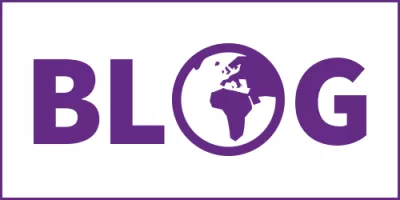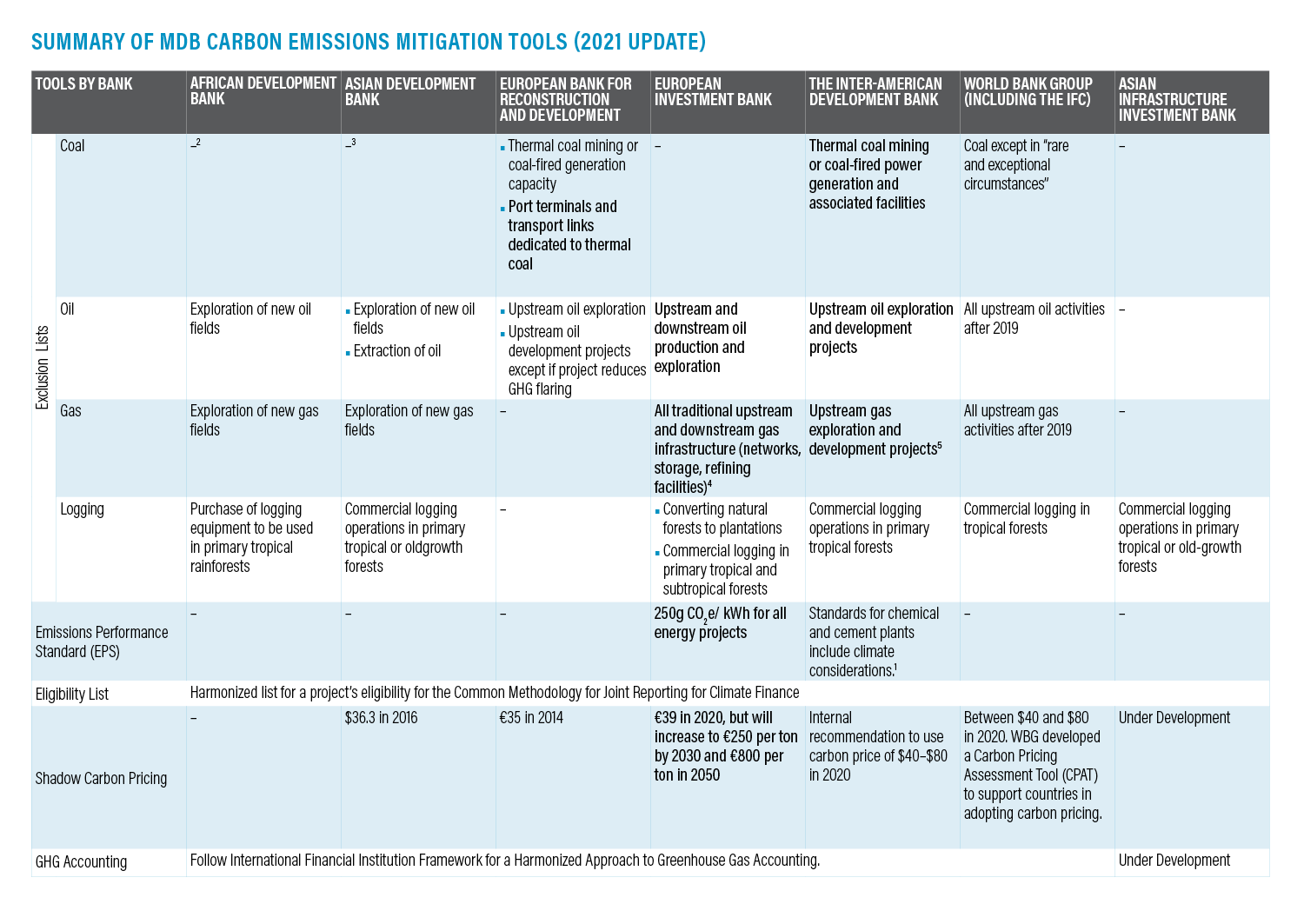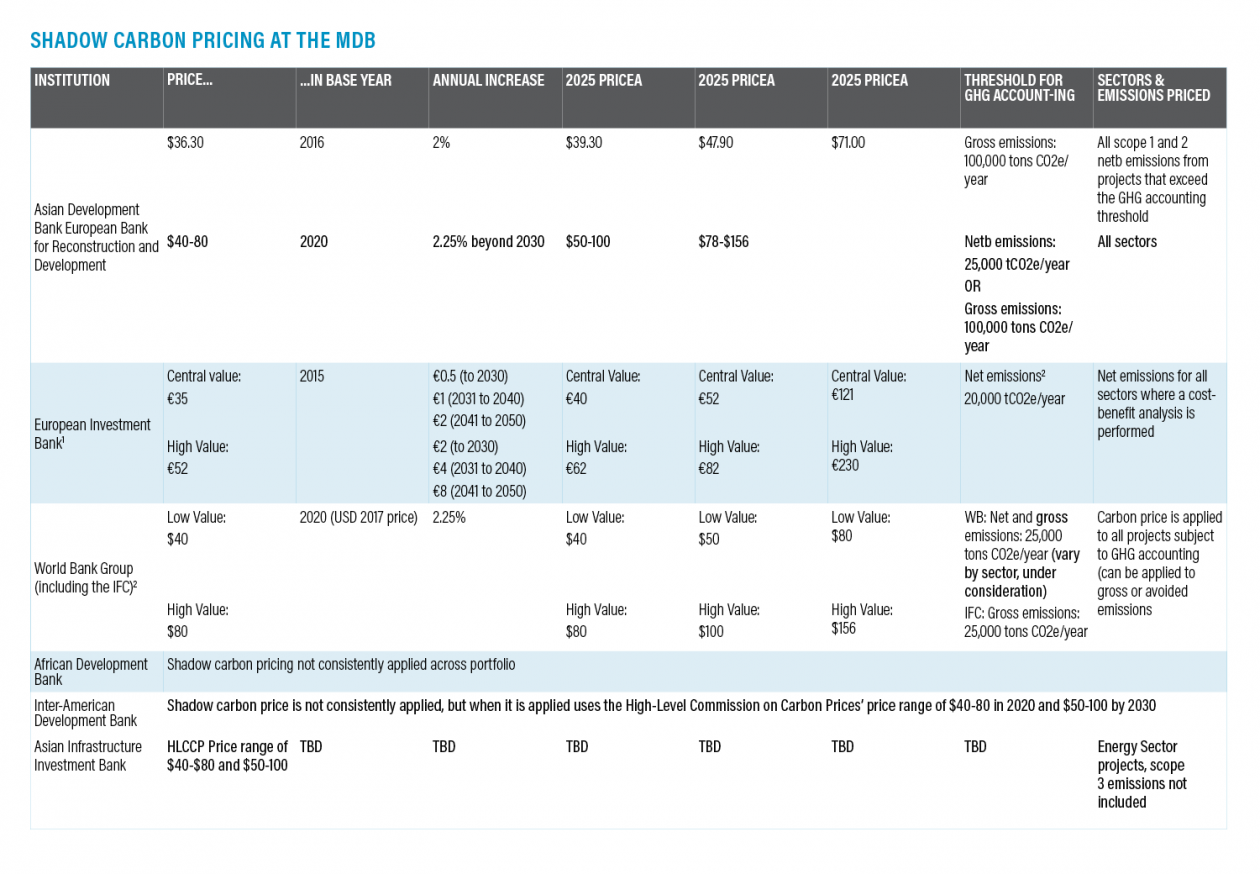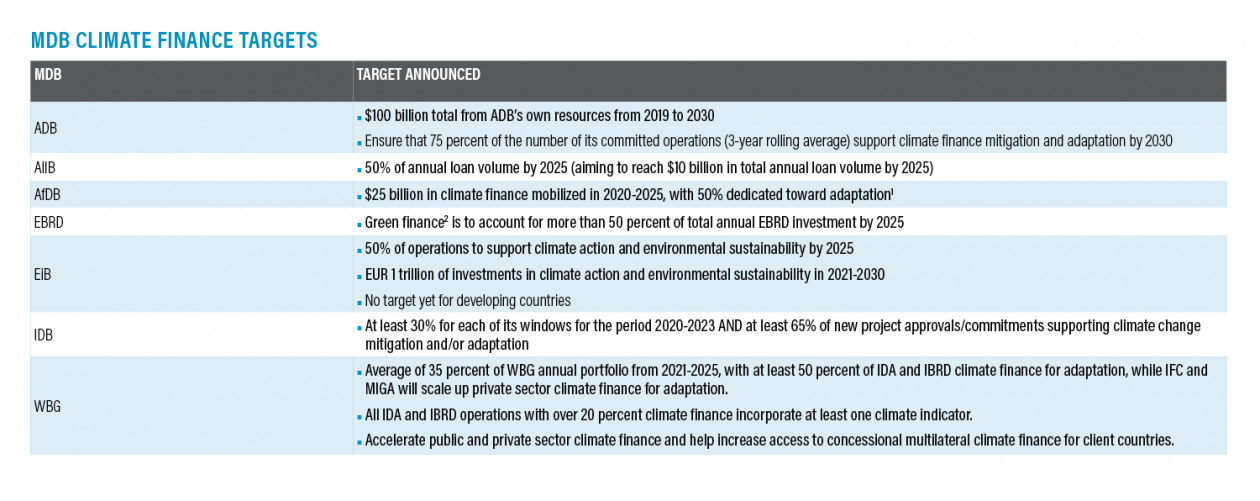MDBs Pledged to Align Financial Flows with the Paris Agreement. They’re Not There Yet

Two years after the 2015 Paris Agreement, the world’s multilateral development banks (MDBs) committed to align their financial flows with the landmark climate pact’s goals.
Now, four years later, it’s clear that as a group, the MDBs are still a long way away from realizing their commitment throughout their portfolios. While MDBs have focused on aligning direct investments with Paris goals, this effort is not sufficiently ambitious, nor is it complete. They have paid less attention to whether their indirect investments support climate goals. And policy-based loans — a favored instrument during times of crisis — also remain a blind spot.
We recently asked MDBs for an update on climate efforts
See their answers at the end of the blogpost
Updating earlier research on MDBs’ Paris alignment pledge, we found that significant progress will be needed for these banks to meet their commitments by 2023-2024. Individual banks are advancing, but their efforts aren’t shared across the group. Effective leadership from MDBs under an ambitious joint framework is key to delivering on their climate commitments.
With COP26 underway, here are the major areas they need to address to show they are leading on alignment efforts with the Paris Agreement.
- Fossil fuel exclusion policies need to be expanded and standardized across institutions. Standard practices on fossil exclusion can strengthen the market signal that fossil fuels’ future is limited. Since 2018, the European Investment Bank and Inter-American Development Bank have formalized new criteria to exclude funding of coal, oil and gas projects. Conversely, the African Development Bank, Asian Infrastructure Investment Bank, Asian Development Bank and World Bank Group have kept emissions-heavy projects in their project pipeline because they lack formal criteria to exclude fossil fuels. In a positive sign, the African Development Bank and Asian Development Bank are expected to formally exclude coal in their updated energy policies and the latter is spearheading plans for an energy transition mechanism to launch public-private partnerships to purchase and retire coal-powered plants.
- MDBs need to standardize how they count and price emissions. The MDBs continue to lack a unified approach to greenhouse gas (GHG) accounting and applying scope 3 emissions. Since 2018, the European Bank for Reconstruction and Development and World Bank Group have expanded their carbon emissions thresholds to account for emissions in more investments. While the African Development Bank has begun piloting project-level GHG accounting, it has set no emissions targets; no other bank has updated its GHG accounting policy since 2018. All MDBs should follow the EBRD, EIB and IDB in publicly reporting portfolio-wide emissions. In setting a shadow carbon price to their activities, many of the MDBs have aligned closely with the High-Level Commission on Carbon Prices (HLCCP)’s recommendation, while others do not consistently apply shadow carbon pricing across projects. The European Investment Bank recently decided not to use a lower-bound value for the price of carbon, raising the overall cost of carbon for all projects and making it less likely the bank will finance emissions-intensive projects.
- With developed countries’ commitment to jointly mobilize $100 billion in annual climate finance likely to fall short by about $20 billion, MDBs will require reforms to help bridge this gap. Almost every bank has made notable progress in ramping up climate finance targets since 2018, especially for the period after 2020. Nevertheless, MDB climate finance to UNFCCC-defined developing countries fell by nearly 5% in 2020 from 2019. With many banks claiming that recent climate finance targets push the limit for what they can provide, a radical shift is needed to meet demand for the transformational investments needed to achieve net-zero emissions by mid-century and to lead the way on adaptation and resilience financing.
Not All Instruments Aligned with Paris
The MDBs also need to take a more holistic approach to Paris alignment, including how they assess climate risks before deciding on operations. While they have made progress on direct investments, other instruments remain uncovered. For example, at the World Bank Group’s International Finance Corporation, many investments are channelled to indirect investments through financial intermediaries. And policy-based financing, in the MDBs that use it, represented most of the support to countries to navigate the COVID-19 crisis.
- Support capacity-building for Paris alignment in financial intermediaries and counterparties. Many MDBs, especially in their private sector windows, intermediate significant proportions of their overall investments through local financial institutions. This allows them to indirectly finance smaller clients or projects and help strengthen domestic financial markets. Typically, however, MDBs do not always know exactly what subprojects will benefit from their financing when an investment is agreed to with a financial intermediary (FI). This requires the FI client, in turn, be Paris aligned, for the MDB to claim that the finance channelled through the FI is Paris-aligned. We propose a risk-based, phased approach to aligning indirect investments that recognizes FIs have varying levels of capacity to implement alignment, and encourages MDBs to support them in this regard. Furthermore, the approach should include a climate risk disclosure process for all projects within the banks’ portfolios. The MDBs will present their joint methodology for aligning indirect financing at COP26. The EIB will also present guidelines for counterparty alignment, going beyond FIs to include corporates. Other MDBs should follow suit in adopting this broader view of due diligence for Paris Alignment.
- Make policy-based financing a tool for climate action. Policy-based financing works by filling the gap of a budget shortfall in exchange for recipient governments completing pre-agreed policy and institutional reforms, or “policy actions.” These reforms can have harmful impacts on a country’s ability to fulfill its climate objectives. For example, the WBG has been shown to incentivize new fossil fuel investments in some projects, through legislation supported by policy-based operations. At the same time, policies and regulations that align government activities with climate goals and increase market incentives for green technologies and practices are critical to setting economies on low-emissions, climate-resilient pathways. Policy-based financing can provide an added incentive for such reforms, as illustrated by IDB support to Costa Rica’s Decarbonization Plan. For Paris alignment, banks that provide policy-based financing will need to ensure policy actions do no harm to climate objectives and, wherever possible, identify opportunities to enable climate-friendly reforms.
Climate Leadership at a Difficult Moment
Development banks are at the nexus of the public and private sectors and the developed and developing worlds. With their ability to provide concessional financing (especially in riskier long-term investments) alongside technical and policy expertise, MDBs should lead, not lag, in the low-carbon, climate-resilient transition.
Against the backdrop of these transformational investment needs, however, runs the more immediate challenge posed by COVID-related debt increases. Aligning all policy frameworks, strategies and financial flows with the Paris Agreement is already a tall order; the pandemic has made this even more challenging. The MDBs are major creditors to developing countries. (For example, the WBG and other multilateral creditors make up 41% of all African debt service). After the pandemic generated fiscal imbalances from high expenditure and low revenue, financial resources have been shrinking. Developing countries may have no choice but to put climate action on the chopping block — which the MDBs (and IMF) must ensure doesn’t happen. The MDBs can forestall this possibility by becoming proactive participants in debt relief initiatives that will protect climate action.
MDBs, however, are not entirely their own masters. Shareholder governments vote on their policies. These parties must provide guidance on how to take Paris alignment from the abstract level of policies and strategies into the operations and nitty-gritty of the MDBs. Ultimately, the mandate to tackle these challenges must come from shareholders.
Recent developments suggest shareholding governments may be up to the task. While progress has been uneven across MDBs, G20 countries themselves have been taking the lead on moving past fossil finance in recent months. The G7 agreed to end international support for coal power earlier this year. The United States released voting guidance to limit MDB investments in fossil fuels more broadly. China has committed to stop building new coal power plants abroad. The Powering Past Coal Alliance — a coalition of governments, businesses and organizations committed to phasing out unabated coal power generation — notably includes 15 developing countries amongst its 41 national government members.
Progress on Paris alignment of all financial flows needs to materialize rapidly in view of the urgency to scale up support for enhanced climate action and the timelines that the MDBs have set for themselves. Their work isn’t finished yet.
This article was originally published on WRI Insights
Updates to “Towards Paris Alignment” (2018): Following Up on MDB Climate Tools in 2021
General Information About Updates
Regular (non-bold) font indicates no change since 2018. Bold font indicates change since 2018.
|
Received responses from:
|
No responses at time of writing (10/29/21) from:
|
MDB Carbon Emissions Mitigation Tools

Notes
- The IDB has industry benchmarks for high-emitting sectors, such as chemical and cement plants. if the GHG emission intensity of a specific plant is significantly higher than the benchmark, the iDB will have to closely scrutinize the planning of the proposed plant for reduction options as part of its engineering review.
- The AfDB does not have an exclusionary policy for coal financing, but has not invested in a new coal project since 2015 and the Bank’s president confirmed in 2019 that the Bank would no longer finance coal projects.
- The ADB will review their coal financing policies in 2021 as part of their ADB Energy Policy Review.
- Exceptions to the natural gas exclusion list include those co-financed with the EU budget through the 4th list of Projects of Common Interest; gas-fired power plants whose emissions standard of 250g CO2e/kWhe is met over the lifetime of the plant; gas network projects planned to transport low carbon gases; and efficient gas-fired boilers applicable for buildings or small and medium enterprises in line with the EU Eco-Design Directive.
- Consideration will be given to financing upstream gas infrastructure that minimizes GHG emissions and improves energy access for low-income populations.
Sources
- Exclusion Lists: ADB (2009a); AfDB (2012c, 2013); AIIB (2016); EBRD (2014b, 2018c, 2020); EIB (2017a, 2020); iDB (2020.); WBG (2013, 2017a).
- Emissions Performance Standards: EIB (2013b); IDB (2011, 2013).
- Eligibility List: MDBs and IDFC (2015a); AfDB et al. (2018).
- Shadow Carbon Pricing: ADB (2017b); EBRD (2014a); EiB (2020); European Commission, (n.d.); WB (2017a).
GHG Accounting Policies by MDB

Notes
- Net emissions are defined as estimated gross emissions within the project-baseline scenario.
- The baseline scenario is estimated gross emissions without the project.
Sources
- ADB (2010, 2017b); AfDB (2016); AIIB (2016, 2018); CiFs (2016, 2017); EBRD (2018, n.d., 2020); EiB (2014, 2015); IDB (2016a); IFC (2011, 2017b); WBG (2016).
Shadow Carbon Pricing at the MDBs

Notes
- Based on the annual increase from the base year used by each bank. As each bank uses a different base year, these prices refer to different years.
- Net emissions = estimated gross emissions with the project – estimated gross emissions without the project (baseline scenario).
- The EBRD is currently revising its policy on shadow carbon pricing and plans to have the revisions complete by the end of 2018.
- 1 Marked as an improvement because the EIB will no longer use the lower bound values for carbon pricing.
Sources
- ADB (2016, 2017a, 2017b); AIIB (2018); European Commission (n.d.); EBRD (2013, 2014, 2018a); EiB (2013a, 2014); IDB (2020); IFC (2016b); WBG (2017b).
MDB Climate Finance Targets

Notes
- The AfDB is adopting a Climate Change and Green Growth Framework consisting of a long-term strategy, short-term action plan, and commitment date at which point the Bank will be Paris-aligned.
- The EBRD does not have separate targets for climate action. Nevertheless, it expects that the bulk of the finance will be classified as climate finance under the joint MDB approach, in line with the EBRD’s current investment focus.
Sources
- ADB (2015); AIIB (2020); AfDB (2016); EBRD (2020); EiB (2015a, 2015b, 2020); IDB (2020); WBG (2020).
Author(s)Brad McCandless, Carolyn Neunuebel, Shuang Liu, Valerie Laxton, Aki Kachi and Anja Gebel |

